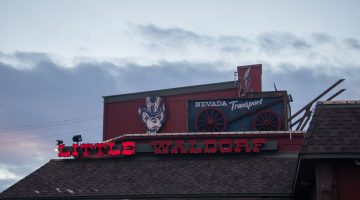
Photo courtesy of NDOW
Black bear cubs sit in a basket in Animal Ark, a wild animal sanctuary. The cubs were brought to Animal Ark by the Nevada Department of Wildlife one day after the
death of their mother was discovered.
By Marcus Lavergne
A rare occurrence shook things up for the Nevada Department of Wildlife and a local animal zoo and sanctuary known as Animal Ark last week. The sanctuary, which is used to taking care of different wildlife ranging from mountain lions and bobcats to wolves, foxes and birds of prey, had its hands full when it became responsible for four wild, orphaned black bear cubs.
According to the department’s public information officer, Chris Healy, there have been 31 bears in similar situations since 1997, but this time things are different because of multiple factors, including the young age of the bears and the largeness of their sleuth or group. Finding four baby bears without a mother at such an early stage in their lives is a peculiar incident, and preparing them for the wild is an adventure in itself.
“Normally if one of these situations occurs, we take possession of the cubs a little bit later in the year,” Healy said. “But now, Animal Ark is going to have to rehab them, keep them away from people and try to get them back into the wild, and they actually have them for close to 11 months.”
The orphaned bears were too young to survive in the wild, and the 18-year-old mother passed away from unknown causes shortly before the cubs left their den. The length of time that they’ll stay under Animal Ark’s supervision, the age of the mother and the number of cubs make for a uniquely challenging situation for the organization.
According to Healy, an 18-year-old mother or sow rarely has any children at all, but for one to have four babies is incredibly unusual.
The department picked up the cubs near Stateline, Nevada, on Saturday, April 9, a day after discovering the mother’s death. After being dropped off at Animal Ark, their long journey to a return to the wild began. The rehab process is one that involves the right type of food for weight gain and minimizing human-to-bear interaction.
The organization’s co-founder, Diana Hiibel, says the process isn’t new, but four bears make things much more complicated.
“First of all, it’s not typical to even find four bear cubs in the wild,” Hiibel said. “It’s not typical for us to take care of four youngsters that need a lot of speciality care in their diet and housing and so forth. It’s not typical in that these bears arrived so much earlier than most of the other cubs.”
The traditional rehabilitation time for the usual orphaned bear cub is about four to six months. Hiibel says the organization is in for a long-term commitment of fattening up the bears and getting them ready for a life in the wild. The methodology behind doing so begins with not forming a relationship with the bears, but according to Hiibel, the cubs are acting wild, and that’s a good thing.
“As cute as they are [and] they’re like the little Disney animals, as cute as a button, they’re little wild animals,” Hiibel said. “We know these behaviors that we’re seeing now are those of fear, ‘I don’t like you, you’re human,’ and we know as they grow up that can be more assertive.”
Hiibel estimates that the cubs are a little over three months old, and most baby bears nurse off their mothers until about five months. These bears are still on formula, and at around 10 pounds, they’ll have a lot of eating to do before getting to the weight they’ll need to be before hibernating.
Soon the organization will have a good system for assessing just how much the bears are eating, and although they’re doing well now with eating and learning about different locations, things still get a bit messy according to Hiibel.
“Bears do not share, and there can be formula all over one bear that doesn’t want to get out of the bowl,” Hiibel said. “We’re learning, but like I said, we’ve had a lot of bears, but not four this young [and] drinking formula.”
The whole endeavor is an expensive, extensive process for the group, but Hiibel says this type of rehabilitation gives the cubs a second chance at a healthy life in the wild. She’s grateful for the support coming from the community since the bears caught the media’s eye.
Healy commends the group for its history of dealing with orphaned bears. Animal Ark has handled 22 out of the last 31 cases, and 25 of the bears have already been successfully freed into the wild. Even though he thinks the organization will face some unforeseen challenges in dealing with four, he believes that in the end the bears will become another success story.
Marcus Lavergne can be reached at mlavergne@sagebrush.unr.edu and on Twitter @mlavergne21.









